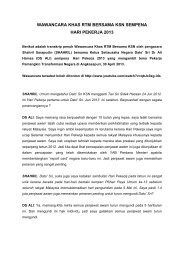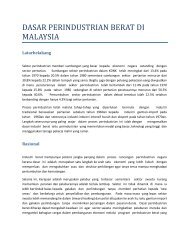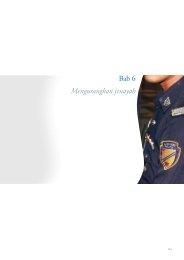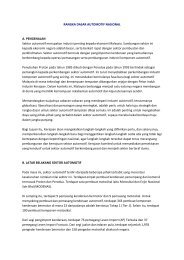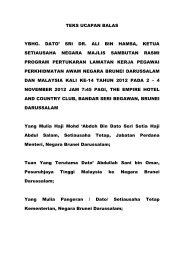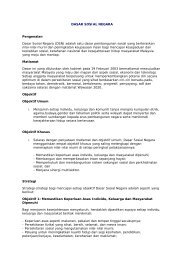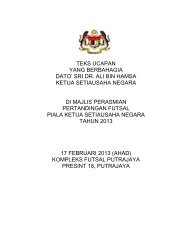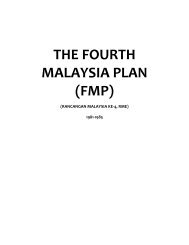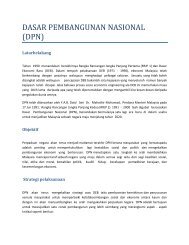GTP 2.0 - Prime Minister's Office of Malaysia
GTP 2.0 - Prime Minister's Office of Malaysia
GTP 2.0 - Prime Minister's Office of Malaysia
Create successful ePaper yourself
Turn your PDF publications into a flip-book with our unique Google optimized e-Paper software.
<strong>GTP</strong> aNNual REPORT:<br />
aGREEd uPON PROCEduRES By<br />
PRICEwaTERHOuSE COOPERS<br />
The Government Transformation Programme (<strong>GTP</strong>) is committed<br />
to high standards <strong>of</strong> transparency and accountability, which<br />
commitment is reflected in the volume <strong>of</strong> information the teams<br />
make available to the public and international reviewers through<br />
various channels. These channels include the Annual Report,<br />
Open Day Q&As as well as the regular publication <strong>of</strong> updates in<br />
the media and on its web sites.<br />
204<br />
The Roadmap for the first horizon for the <strong>GTP</strong>,<br />
otherwise known as <strong>GTP</strong> 1.0, was published in<br />
2009 and contains a detailed structure <strong>of</strong> the<br />
programme’s plans and targets. The results <strong>of</strong><br />
the initiatives in 2012 are measured against<br />
this backdrop for each specific National Key<br />
Result Area (NKRA) and are published in this<br />
annual report.<br />
Greatest care has been made to ensure<br />
that the results published in this annual<br />
report are as transparent as possible, with<br />
greatest care taken to ensure that the results<br />
collected and tabulated are accurate. To this<br />
end, PEMANDU engaged an independent third<br />
party, PricewaterhouseCoopers <strong>Malaysia</strong> (PwC),<br />
to ensure consistency and accuracy in the<br />
<strong>GTP</strong>’s methods, including data collection and<br />
measurement. PwC, an independent pr<strong>of</strong>essional<br />
services firm, established a series <strong>of</strong> Agreed<br />
Upon Procedures (AUPs)–specific tests and<br />
procedures to review reported results–for the<br />
KPIs. The AUPs were applied to a sample taken<br />
from the key performance indicators <strong>of</strong> each<br />
NKRA and agency. Each NKRA’s calculations were<br />
also checked against guidelines and formulae<br />
originally developed in the NKRAs’ labs and<br />
prescribed by PEMANDU.<br />
Over the course <strong>of</strong> this exercise, PwC’s findings<br />
highlighted a number <strong>of</strong> exceptions on the<br />
samples selected, which were subsequently<br />
addressed and are reflected in this Annual<br />
Report. PwC has confirmed that the results<br />
reported for the selected samples in the Annual<br />
Report have been validated according to the<br />
AUPs. PwC also identified opportunities to<br />
improve processes and the quality <strong>of</strong> information.<br />
By working together with the relevant Ministries<br />
and private sector stakeholders, PEMANDU will<br />
take prescriptive action to implement these<br />
improvements over the next 12 months.<br />
Government transformation Programme—Annual Report 2012 IPR<br />
2012 NKRa Performance<br />
and Expenditure Budget<br />
205<br />
In the interest <strong>of</strong> transparency and accountability, we present<br />
here a detailed summary <strong>of</strong> the NKRA performance and<br />
expenditure budget. One <strong>of</strong> the key distinctions <strong>of</strong> the <strong>GTP</strong> is<br />
its emphasis on cost effectiveness rather than expenditure. The<br />
<strong>GTP</strong> adopts a preference for budget savings, where possible, as<br />
long as it does not impede the achievements <strong>of</strong> the NKPIs.<br />
mEasuRING thE aChIEvEmENts oF thE GtP<br />
Three varying scoring methodologies were used to assess the success <strong>of</strong> the NKPIs and the NKRAs.<br />
Each one has a varying level <strong>of</strong> strictness (added rules) providing three different testing benchmarks.<br />
The rationale for this approach is to ensure that the results achieved are truly robust. The scoring<br />
methodologies are explained below:<br />
Scoring Method description<br />
Method 1 Scoring is calculated by a simple comparison against set 2012 targets.<br />
The overall NKRA composite scoring is the average <strong>of</strong> all scores<br />
Method 2 Scoring is calculated by dividing actual results against set 2012 targets with an<br />
added rule:<br />
If the scoring is less than 100%, score #2 is taken as the actual percentage<br />
If the scoring is equal or more than 100%, score#2 is taken as 100% The<br />
overall NKRA composite scoring is the average <strong>of</strong> all scores<br />
Method 3 Scoring is calculated by dividing actual results against set 2012 targets with an<br />
added rule:<br />
If the scoring is equal and less than 50%, score #3 is indicated as 0<br />
If the scoring is more than 50% and less than 99%, score #3 is<br />
indicated as 0.5<br />
If the scoring is equal or more than 100%, score #3 is indicated as 1<br />
Government transformation Programme—Annual Report 2012 Performance & Expenditure





